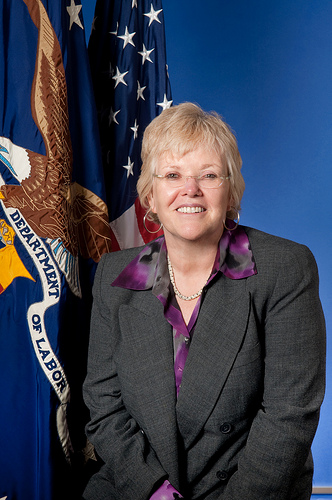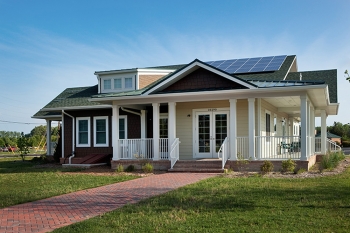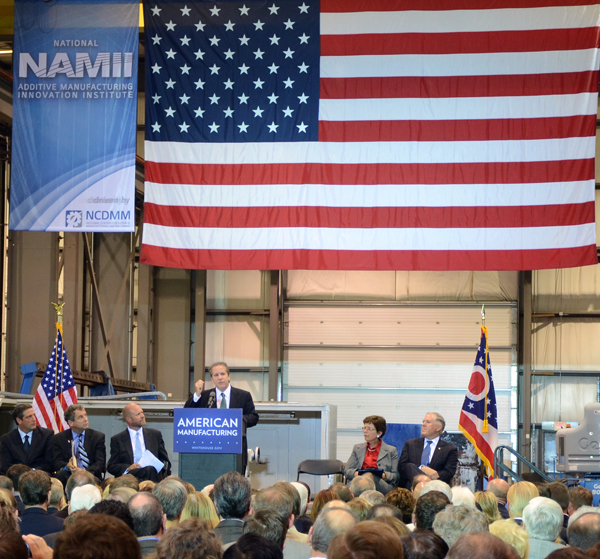
MAY 2013
|
The mission of the Economic Development Administration (EDA) is to lead the federal economic development agenda by promoting innovation and competitiveness, preparing American regions for growth and success in the worldwide economy. The agency has a competitive grant process and has established the following investment priorities as criteria: collaborative regional innovation, public/private partnerships, national strategic priorities, global competitiveness, environmentally sustainable development, and economically distressed and underserved communities.
Message from Deputy Assistant Secretary
|
 |
|
Jane Oates |
In April 2009, President Obama nominated Jane Oates to join the leadership team at the Department of Labor. Confirmed as Assistant Secretary for Employment and Training in June 2009, she leads the Employment and Training Administration (ETA) in its mission to design and deliver high-quality training and employment programs for our nation’s workers. Prior to her appointment, Ms. Oates served as executive director of the New Jersey Commission on Higher Education and senior advisor to Governor Jon S. Corzine. Ms. Oates also served for nearly a decade as senior policy advisor for Massachusetts Senator Edward M. Kennedy, where she worked on major workforce initiatives, including the Workforce Investment Act of 1998.
Assistant Secretary Oates recently answered some questions about the administration’s efforts to prepare American workers, especially women, for jobs in growing industries, and the successful collaborations her agency has undertaken in partnership with EDA and other federal agencies.
Question: How has the U.S. Department of Labor’s Employment and Training Administration advanced President Obama’s commitment to better position workers in general, and women in particular, for success in the global workplace?
A: In his State of the Union address, President Obama said the United States must be a magnet for job creation. Having a skilled workforce is critical to encouraging more business development and investment in this country and will ensure our ability to compete in the global marketplace. Over the past several years, the U.S. Labor Department has invested billions of dollars to prepare workers in high-growth and emerging industries like health care, information technology, green jobs, and advanced manufacturing. As we’ve made these investments, we have sought to ensure that women, veterans, minorities, and other vulnerable populations benefit from these training opportunities.
President Obama, former Labor Secretary Hilda Solis, and now Acting Labor Secretary Seth Harris have made it a priority to ensure access to high-wage occupations in science, technology, engineering, and mathematics (STEM) jobs is available to more women. This is one step toward the administration’s goal of reducing the wage gap between men and women. Through our efforts, we are seeing more women participate in registered apprenticeship programs—learning the latest skills in biosciences, IT, and welding, among others skills.
More broadly, the Employment and Training Administration, and its state and local workforce partners, funds about 2,700 American Job Centers across the country that offer training and employment services to workers and jobseekers. As we recover from one of the worst recessions in the country’s history, these centers are providing critical training assistance, job search advice and resources, and information about unemployment benefits to help workers and their families get back on their feet.
Question: What is being done to close the skills gap between today’s workers and the needs of employers in emerging industries, particularly for women? Can you cite some examples of training programs?
A: I’m excited about many of ETA’s initiatives that are preparing workers for growing industries. In 2011, ETA launched the Trade Adjustment Assistance Community College and Career Training initiative that made available $2 billion over four years in grants to community colleges and universities around the country to develop and expand innovative training programs. By partnering with local employers, these two-year degree granting institutions are able to design a curriculum that ensures these programs equip students with skills employers are actually looking for in growing fields like advanced manufacturing, transportation, and health care.
The department has also made investments through the Women in Apprenticeship and Nontraditional Occupations program. These grants are supporting innovative projects that improve the recruitment, hiring, training, employment, and retention of women in apprenticeships—paving the path to good careers in thriving industries where women typically account for only a quarter or less of the workforce
Initiatives like these are a great example of what President Obama described in his State of the Union address, when he talked about partnerships that promote the development of “skills today’s employers are looking for to fill the jobs that are there right now and will be there in the future.”
Question: The U.S. Departments of Labor and Commerce have collaborated on various inter-agency initiatives, such as the Jobs and Innovation Accelerator Challenge. What will be the long-term impact on America’s workforce?
A: The Jobs and Innovation Accelerator Challenge is a great example of federal agencies working together to promote economic strength at a local or regional level. Through the initiative, we’ve provided tens of millions of dollars in grants to advance training in high-growth areas such as advanced manufacturing, information technology, aerospace, clean technology, and other fields. The training has benefits at multiple levels. Students emerge with marketable skills. Employers have access to a greater pool of skilled, knowledgeable workers. The local- and regional-level focus on this initiative means that communities actively identify the kind of training that would have the greatest benefit for their workers and businesses.
[Recently], a number of agencies, including the Departments of Labor and Commerce, announced the Make it in America Challenge. This is a $40 million grant initiative to encourage the development of critical infrastructure, strategic planning, capacity building, and technical assistance that will attract business investment and job creation in local communities around the country.
Through these collaborative efforts, we are creating an environment for economic growth and preparing a workforce that meets the needs of industries that are expanding by bringing economic development and workforce development together in a coordinated manner to strengthen the competitiveness of regional economies. A stronger workforce means stronger American businesses and a stronger American economy.
Highlight
Applications Sought for Make it in America Challenge
Initiative Encourages Businesses to Bring Production Back to the United States or Expand Domestic Operations
The deadline to submit an application is May 31, 2013. For information on how to apply, click here.
The Obama administration made funding available for the Make it in America Challenge to encourage foreign and domestic businesses to build and/or expand their operations in the United States.
Up to 15 awards will be made to accelerate job creation by encouraging re-shoring of productive activity by U.S. firms, fostering increased foreign direct investment, encouraging U.S. companies to keep or expand their businesses—and jobs—here at home, and training local workers to meet the needs of those businesses.
Funding partners for this coordinated assistance include the U.S. Department of Commerce’s Economic Development Administration (EDA) and National Institute of Standards and Technology Manufacturing Extension Partnership (NIST MEP); the U.S. Department of Labor’s Employment and Training Administration (ETA); and the Delta Regional Authority (DRA).
Spotlight
President’s FY14 Budget Strengthens EDA’s Capacity to Support Local and Regional Job Growth
Targeted Investments in American Manufacturing, Infrastructure, and Exports
The full Department of Commerce FY 2014 budget request can be found here (PDF).
The U.S. Department of Commerce’s fiscal year 2014 budget request supports President Obama’s plan for an economy built to last with crucial investments in advanced manufacturing, innovation, trade promotion and enforcement, and research and development.
Critically, the president’s FY 2014 budget strengthens the Economic Development Administration’s capacity to invest in many of these key areas by supporting the agency’s priorities and flagship investment programs at the highest level of funding in more than 10 years.
To bolster EDA’s efforts to create jobs and attract and increase business investment in communities across the nation, the FY 2014 budget also proposes:
Revitalizing American manufacturing: The President’s budget includes $113 million for the creation of the Investing in Manufacturing Communities Partnership (IMCP)—a multi-agency initiative housed within the department’s Economic Development Administration (EDA) that will help American communities attract manufacturers and their supply chains. IMCP will provide targeted financial assistance to manufacturing communities while also leveraging non-federal funds to invest in infrastructure projects and research facilities that will promote long-term economic growth.
Increasing exports: The President’s budget includes $12 million for EDA to create a Regional Export Challenge to assist communities in developing robust and sustainable export action plans that support jobs.
Investing in Manufacturing Communities PartnershipOn April 17, in Mesa, Arizona, Deputy Secretary of Commerce Rebecca Blank announced the Investing in Manufacturing Communities Partnership (IMCP), an Obama administration initiative that will help accelerate the resurgence of manufacturing and create jobs in cities across the country. For more information, click here. Click here for Dr. Blank's remarks on manufacturing and the IMCP |
Success Story
EDA-Supported “Energy House” in Delaware Provides Training to Workers in a Growing Sector
 |
|
Energy House at Delaware Technical and Community College’s Georgetown campus |
In his State of the Union message to Congress in February, President Obama emphasized the importance of worker training to meeting the needs of today’s economy and to ensuring America’s competitiveness. An EDA-supported training facility that opened last year at Delaware Technical and Community College’s campus in Georgetown, Delaware, is an excellent example of the long-term investments that are being made to support the president’s goal.
Energy House, designed to resemble an actual residence, serves as an educational lab where students can learn about innovative, energy-efficient technologies and renewable materials. In addition to the standard array of living room, kitchen, bedroom, and household appliances, there are also two state-of-the-art classrooms, a conference room, and see-through wall galleries that demonstrate the technologies and materials used in the building’s construction. Cutting-edge green technologies—such as solar systems, wind power generation equipment, a living green roof, and geothermal options—are an integral part of the building’s construction.
The opportunities in the green technology industry are promising. A recent study by the Brooking Institution found that the sector employs about 2.7 million workers nationwide, and is experiencing healthy growth—adding about half a million jobs between 2003–2010, an annual growth rate of 3.4 percent. Median wages for green jobs, according to the Brookings researchers, were 13 percent higher than median U.S. wages overall. And many of these so-called “green collar” jobs are available to skilled individuals with relatively little formal education.
Development of the Energy House was an important collaboration for the state government, local leaders, Delaware Technical and Community College, and EDA. As a result of the joint investment, Delaware now has an outstanding resource where job seekers—from high school graduates, to career changers, to laid-off workers—can get the skills they need to thrive in the growing green technology sector.
Investing in Manufacturing
Innovation Institutes Will Support Manufacturing and Create Jobs
 |
|
White House National Economic Council Director Gene Sperling speaks at an event in August 2012 announcing that Youngstown, Ohio, had been chosen as the site for a major federal institute for manufacturing innovation. (photo courtesy Youngstown State University) |
In February, President Obama proposed a one-time, $1 billion investment to launch a network of 15 manufacturing innovation institutes across the country. Leveraging the strengths of a particular region, each institute will bring together businesses, universities and community colleges, and government to co-invest in the development of world-leading manufacturing technologies and capabilities that U.S.-based manufacturers can apply in production.
In August 2012, a pilot institute was launched in Youngstown, Ohio, with a $45 million funding commitment from five federal agencies, led by the Department of Defense. The winning partnership of firms and universities from Ohio, Pennsylvania, and West Virginia was one of 12 teams that applied.
While the full proposal to establish 15 institutes will require Congressional action, the president announced that he will take executive action to launch three new manufacturing innovation institutes in 2013. These will build on the success of the pilot institute, and will be a co-investment between federal agencies, led by the Departments of Defense and Energy, and the private sector. Their initial focus will be on manufacturing technologies that also address critical national security and energy needs.
To read more about the proposed manufacturing innovation institutes, click here.
|
|
|||
In This Issue
EDA Announces Funding for University Center ProgramEDA has released its fiscal year 2013 Federal Funding Opportunity for its University Center competition. Qualified applications are sought from institutions located in EDA’s Austin and Denver regions. The University Center Economic Development Program assists institutions of higher education and consortia of institutions of higher education in establishing and operating centers specifically focused on leveraging university assets to build regional economic ecosystems that support high-growth entrepreneurship. Competitive applications will only be accepted from accredited institutions that are located in, and have programs targeting, the following geographic areas: Austin Region: including Arkansas, Louisiana, New Mexico, Oklahoma, and Texas Denver Region: including Colorado, Iowa, Kansas, Missouri, Montana, Nebraska, North Dakota, South Dakota, Utah, and Wyoming The deadline to submit an application is June 17, 2013. For information on how to apply, click here.
Save the Date:
|
 |
On April 4, Deputy Assistant Secretary Matt Erskine met with city officials of Bangor, Maine, and management of C&L Aerospace to hear about their plans to construct an aircraft painting facility in a city-owned hangar, which will be leased to C&L. The project will allow the company to expand its aircraft repair and refurbishment services, secure more international contracts, and add an estimated 70 new employees.
EDA’s Hurricane Sandy Relief Efforts Continue in New York and
New Jersey
 |
EDA continues to work with state and local officials and businesses in New York and New Jersey to help communities recover from Hurricane Sandy. Two teams of EDA employees—working out of Queens, New York, and Lincroft, New Jersey—have built strong coalitions of state, local, and federal partners to conduct mission scoping assessments and develop a Recovery Support Strategy. This strategy will guide the technical assistance activities that EDA’s teams will pursue with their federal and state partners in the coming months to support long-term recovery efforts.
To help businesses in one particularly hard-hit industry—tourism—EDA partnered with another Commerce Department agency, the International Trade Administration (ITA) and the state of New Jersey to organize a Tourism Peer-to-Peer Workshop that was held in Atlantic City on March 20.
Tourism is the third largest private-sector employer in New Jersey, and is especially important in the coastal areas that were most affected by Hurricane Sandy. According to a study conducted for VisitNJ, New Jersey’s tourism industry directly supported 312,000 jobs in 2011, or nearly 10 percent of the state’s total employment.
The March workshop brought together 50 tourism professionals from areas of the Gulf region that had been affected by the Deepwater Horizon oil spill of 2010 and recent hurricanes like Katrina, Rita, Irene, Ivan, and Ike. The participants shared their experiences with disaster response and highlighted the strategies they used to help communities and businesses recover from disasters that had a devastating impact on their tourism sector.
Click here to learn more about EDA’s disaster recovery efforts.
Putting America Back to Work: Invest in American Jobs Act of 2013
A new bill recently introduced into the House of Representatives, the Invest in American Jobs Act of 2013, would strengthen Buy American requirements for future investments in highway, bridge, public transit, rail, and aviation infrastructure. If enacted, the law would strengthen existing Buy American preferences; close loopholes to ensure that infrastructure investments—including Economic Development Administration grants—use domestic contents; and bring greater accountability to any waivers that may be requested under these requirements. According to research conducted for the Alliance for American Manufacturing, maximizing the use of domestic content with a Buy American preference would result in significant increases in manufacturing employment, with an estimated 18,000 new jobs for every $1 billion in new infrastructure spending.
Upcoming Economic Development Events

May 15-17, 2013
Brownfields 2013 Conference, Atlanta, Georgia
May 31, 2013
Make it in America application deadline
June 23-26, 2013
National Association of Regional Councils 47th Annual Conference, Philadelphia, Pennsylvania
July 17-19, 2013
2013 National Rural Economic Developers Association Annual Conference, Austin, Texas
July 19-22, 2013
National Association of Counties Annual Conference and Exposition, Fort Worth, Texas
